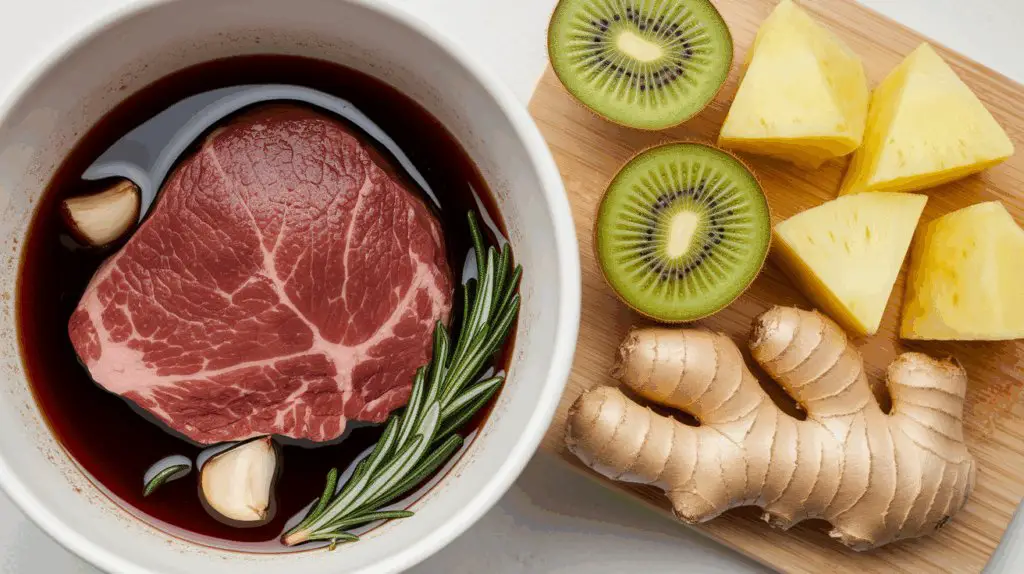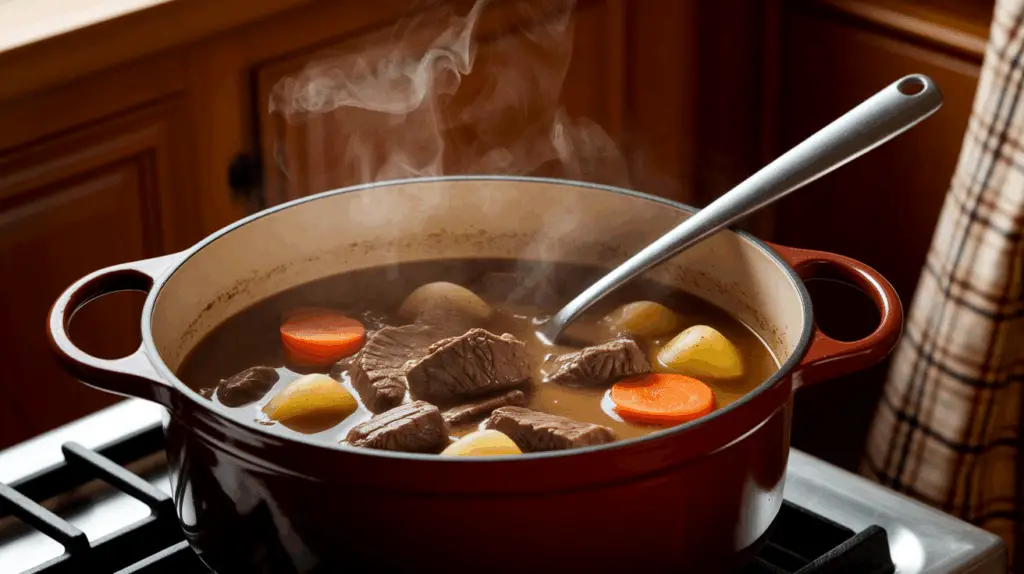Hey there, fellow home cook! Have you ever excitedly anticipated a hearty beef stew, only to find yourself chewing on tough, rubbery bits of meat? It’s the worst, isn’t it? We’ve all been there. But fear not! Mastering how to tenderize stew meat is simpler than you think, and it doesn’t always involve hours of slow cooking (though that helps!). We’re talking about clever techniques that transform even the toughest cuts into unbelievably tender, flavorful morsels. Let’s get that tender meat on your fork!
Understanding the “Why”: What Makes Stew Meat Tough?
Before we tenderize, let’s quickly understand why stew meat can be so stubbornly tough. Typically, stew meat comes from hard-working parts of the animal, like the chuck, round, or shank. These cuts are packed with connective tissue, especially collagen. When cooked incorrectly, this collagen tightens up, making the meat chewy. Our goal in tenderizing is to break down this collagen, turning it into gelatin, which then gives the meat that luscious, melt-in-your-mouth texture. This is key to cooking stew meat properly.
The Magic Powder: Baking Soda to Tenderize Meat
Okay, buckle up, because we’re starting with a secret weapon that many professional kitchens swear by: baking soda! Yes, the same stuff you use to bake cookies or deodorize your fridge can work wonders on meat. This is hands down one of my favorite how to tenderize beef tricks.
How Baking Soda Works Its Magic
Baking soda to tenderize steak (or stew meat!) works by raising the pH level on the meat’s surface. This alkaline environment makes it harder for the meat proteins to bond tightly, effectively loosening them up. The result? Incredibly tender meat in a surprisingly short amount of time. This technique is often referred to as velveting beef with baking soda or simply velveting meat, and it’s a game-changer for stir-fries, but it’s just as effective for stew meat.
Applying Baking Soda to Stew Meat: The Simple Steps
- Prep the Meat: Cut your stew meat into your desired chunks.
- Sprinkle & Coat: For roughly 1 pound of stew meat, sprinkle about 1 teaspoon of baking soda evenly over the meat. Use your hands to thoroughly mix it, ensuring every piece is lightly coated. You’re not trying to create a thick paste, just a thin, even layer.
- Rest: Place the coated meat in a bowl, cover it, and let it rest in the refrigerator for at least 20-30 minutes. For tougher cuts or larger batches, you can go up to an hour, but generally, 20-30 minutes is enough for good results on stew meat beef tips.
- Rinse Thoroughly: This step is crucial! After resting, rinse the meat vigorously under cold running water. You need to wash off all the baking soda. If you don’t, your meat might have a slightly soapy or metallic taste. Give it a good rinse for a minute or two, then drain it well.
- Pat Dry: Use paper towels to pat the meat completely dry. This helps tremendously with browning later on, creating a delicious crust.
- Cook as Desired: Now your meat is primed for cooking! Proceed with your stew recipe as usual. You’ll notice a remarkable difference in tenderness. This is truly an effective meat tenderizer recipe.
Baking Soda Benefits Beyond Tenderness
Beyond just breaking down proteins, using baking soda on beef can also promote better browning. The slightly altered surface pH can lead to a more intense Maillard reaction, giving your stew meat a richer, deeper flavor when seared. It’s truly one of the most effective natural meat tenderizers you have in your pantry! Just be mindful not to overdo it; too much baking soda or too long a soak can make the meat mushy, which is definitely not what we want!
Acidic Marinades: The Classic Tenderizer
While baking soda is quick, acidic marinades are a time-honored way to tenderize and infuse flavor simultaneously. This is where you get into some fantastic stew meat marinade and beef stew meat marinade options.
How Acid Works to Tenderize
Acids like vinegar, lemon juice, buttermilk, or even certain fruits (like pineapple or kiwi, used sparingly!) work by denaturing proteins. They start to unravel the meat’s fibers, making them softer. The longer the meat marinates, the more tender it becomes, up to a point. Too long in a highly acidic marinade can actually make the meat mushy or grainy, so don’t overdo it!
Best Acidic Marinade Ingredients for Stew Meat
- Vinegar: Red wine vinegar, balsamic vinegar, or apple cider vinegar all work wonderfully. They add tang and help break down those tough fibers.
- Citrus Juices: Lemon juice, lime juice, or orange juice can provide a bright, zesty tenderization.
- Dairy: Buttermilk or yogurt (especially plain Greek yogurt) are fantastic. Their lactic acid gently breaks down fibers while also keeping the meat moist. They’re excellent for chicken but also effective for beef.
- Wine/Beer: Red wine or a dark beer not only add depth of flavor but also contain acids that contribute to tenderization.
Crafting Your Stew Meat Marinade: Tips for Success
- Choose Your Acid: Pick one or a combination based on your desired flavor profile.
- Add Flavor Boosters: Don’t just stop at acid! Include aromatics like sliced onions, smashed garlic cloves, fresh herbs (rosemary, thyme, bay leaves), and of course, salt and black pepper. A dash of Worcestershire sauce can also add incredible umami. This creates a powerful marinade for beef stew meat.
- Oil It Up: A little olive oil in the marinade helps distribute fat-soluble flavors and can keep the meat from drying out.
- Marinate in the Fridge: Place the meat and marinade in a non-reactive dish or a zip-top bag. Ensure the meat is fully submerged. Marinate in the refrigerator for at least 4-6 hours, or ideally overnight (12-24 hours). For very tough cuts, you can go up to 48 hours, but check for texture as you don’t want it to get mushy.
- Pat Dry (Again!): When you’re ready to cook, remove the meat from the marinade and pat it thoroughly dry with paper towels. Excess moisture will prevent a good sear. Discard the used marinade.
The Power of Enzymes: Fruit & Ginger Tenderizers
Some fruits contain natural enzymes that are potent meat tenderizers. These are excellent natural meat tenderizers that you can use!
- Pineapple: Contains bromelain.
- Kiwi: Contains actinidin.
- Papaya: Contains papain.
A little bit goes a long way with these, as their enzymes are very effective and can quickly turn meat mushy if used in excess or for too long. A good rule of thumb is to use 1-2 tablespoons of crushed fruit per pound of meat for no more than 30-60 minutes. Rinse thoroughly before cooking.
Ginger: Fresh ginger also contains proteolytic enzymes that can tenderize meat. Grate fresh ginger and rub it onto the meat, letting it sit for about 30 minutes before rinsing. This also adds a fantastic, warm flavor profile.
These enzymatic approaches are great for general beef tenderizer applications, but be very cautious with stew meat, as too much tenderization could result in a less desirable texture after long cooking.
The Low & Slow Method: Time is Your Ally
Sometimes, the best how to cook stew beef tender method is simply patience. Slow cooking at a low temperature is the traditional way to break down all that tough collagen into luscious gelatin. This is why dishes like pot roast and beef stew are so comforting.
Tips for Low & Slow Tenderization:
- Sear First: Even if you’re slow cooking, always sear your stew meat first. This develops a deep, rich flavor (the Maillard reaction) and a beautiful color that you can’t get from just simmering. Heat a little oil in your pot until smoking hot, then sear the meat in batches until well-browned on all sides. Remove the meat.
- Deglaze: After searing, add liquid (broth, wine) to the hot pan to scrape up all those flavorful browned bits (fond). This adds immense depth to your stew.
- Ample Liquid: Ensure your stew meat is mostly submerged in liquid (broth, stock, tomatoes, wine) throughout the cooking process. This provides the moisture needed for the collagen to convert.
- Consistent Low Heat: Whether in a Dutch oven on the stovetop (barely simmering), in an oven at 300-325°F (150-160°C), or in a slow cooker, maintain a consistent low temperature. This is key for collagen breakdown without drying out the meat.
- Time is Key: Depending on the cut and size of your chunks, stew meat typically needs at least 2-3 hours of simmering, often up to 4 hours or more, to become truly fork-tender. Don’t rush it! The meat is done when it shreds easily with a fork. This ensures you master cooking stew meat.
Mechanical Tenderization: Pounding and Piercing
For some cuts, a little physical intervention can help. While less common for chunky stew meat, these methods are useful for smaller pieces or thinner cuts you might consider for a quick stew.
- Pounding: Using a meat mallet can break down muscle fibers and flatten the meat. This is great for making tender steak tips from tougher cuts like sirloin (if you’re using it for quick stewing, for example, not a classic thick cut). If you’re wondering how to tenderize sirloin steak for something other than a whole roast, this can be an option.
- Piercing: A fork or a specialized blade tenderizer can create tiny holes, breaking up fibers and allowing marinades to penetrate deeper.
These methods are more about breaking up muscle fibers than converting collagen, but they still contribute to a more tender result.
Beyond Tenderness: Flavorful Stew Meat Ideas
Now that your stew meat is tender, what delicious dishes can you create? The possibilities for dishes with stew meat are endless!
- Classic Beef Stew: The quintessential comfort food, with carrots, potatoes (maybe some ground beef and potatoes if you want to mix it up, though typically chunked beef!), onions, and a rich gravy.
- Beef Bourguignon: A French classic, braised in red wine with mushrooms and pearl onions.
- Chili Con Carne: While often made with ground beef, cubed stew meat, slow-cooked until tender, makes for an incredibly rich and satisfying chili.
- Beef Ragu: Simmered for hours with tomatoes and aromatics, perfect tossed with pasta or polenta.
- Curries: Indian or Thai-inspired curries with tender beef chunks are sublime.
- Pot Pies: Shredded tender beef stew meat makes an incredible filling for a savory pot pie.
- Roast Beef Tips: For quick roast beef tips, tenderize the meat (maybe with baking soda for speed!), sear, and then simmer briefly in a rich gravy.
- Stroganoff: Tender beef stew meat can be wonderful in a creamy mushroom Stroganoff.
Remember, the goal is always tender meat that’s bursting with flavor. With these techniques, you’ll be a stew meat tenderizing wizard in no time!
Tips for Success & Common Questions
- Don’t Rush the Sear: Even if you’re using tenderizers, browning your stew meat properly before adding liquids builds incredible depth of flavor.
- Choose the Right Cut: While tenderizing helps, some cuts are naturally better for stewing. Chuck roast is a top choice due to its ideal fat-to-collagen ratio.
- Cut Uniformly: Try to cut your stew meat into relatively uniform pieces for even cooking and tenderization.
- Homemade Meat Tenderizer: You can make a simple homemade meat tenderizer by combining salt, pepper, garlic powder, onion powder, and a pinch of active dry yeast (the enzymes in yeast can also help break down fibers, though less common than baking soda). For a more acidic option, lemon zest, black pepper, and salt can also contribute to a mild tenderizer.
- Steak Tenderizer Recipes: While the focus here is stew meat, many of these methods (especially baking soda and acidic marinades) are excellent steak tenderizer recipes for tougher cuts like flank or skirt steak that you plan to grill or pan-fry quickly. For instance, tenderize steak with baking soda for a stir-fry is a common culinary trick.
Frequently Asked Questions
Q1: What is the fastest way to tenderize stew meat? A1: The fastest way to tenderize stew meat is often by using baking soda. Sprinkle 1 teaspoon per pound of meat, let it sit for 20-30 minutes, then rinse thoroughly and pat dry before cooking.
Q2: What can I use to tenderize beef that is tough? A2: You can tenderize tough beef using baking soda, acidic marinades (vinegar, lemon juice, buttermilk), enzymatic tenderizers (pineapple, kiwi, ginger), mechanical methods (pounding), or by cooking it low and slow for an extended period.
Q3: How much baking soda do you use to tenderize meat? A3: Generally, use 1 teaspoon of baking soda per pound of meat. Mix it thoroughly to coat all surfaces, let it sit for 20-30 minutes, then rinse very well and pat dry.
Q4: Does vinegar make meat tender? A4: Yes, vinegar’s acidity helps to denature proteins in meat, breaking down tough fibers and resulting in more tender meat, especially when used as part of a marinade.
Q5: What meat is best for stewing? A5: Cuts of meat that are best for stewing are those with a good amount of connective tissue and fat, such as chuck roast, beef short ribs, beef round (rump roast), or beef shank. These become fork-tender with slow cooking.
Q6: How long should you marinate stew meat? A6: Marinate stew meat in an acidic marinade for at least 4-6 hours, and ideally overnight (12-24 hours) in the refrigerator. For very tough cuts, up to 48 hours is possible, but avoid over-marinating, which can make meat mushy.
Q7: Can you put raw meat tenderizer powder on beef stew meat? A7: Yes, you can use commercial meat tenderizer powder on beef stew meat, following the product’s instructions. These powders typically contain enzymes like papain (from papaya) or bromelain (from pineapple) that break down meat fibers.
Conclusion
So there you have it, fellow kitchen warrior! Conquering tough stew meat is totally within your grasp. Whether you opt for the quick magic of baking soda to tenderize steak, the flavorful embrace of an easy steak marinade recipes, or the timeless patience of a low and slow simmer, you now have the tools to achieve truly tender meat every single time. Go forth, transform those humble chunks into culinary masterpieces, and enjoy every melt-in-your-mouth bite of your next delicious stew! Happy cooking! 🙂




